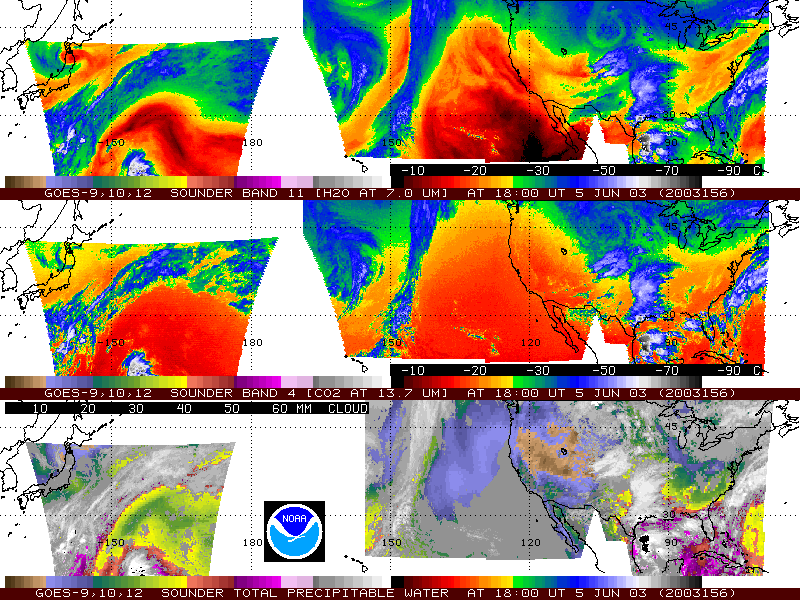
[ Archive ]

 |
CIMSS-NOAA Weekly Report
[ Archive ] |
 |
IN THE PRESS:
ITEMS FOR THE ADMINISTRATOR:
ITEMS FOR THE ASSISTANT ADMINISTRATOR:
ITEMS FOR THE OFFICE DIRECTOR, ORA:
Modernized Sensor Processing System GOES-12 Test: The Space Science and Engineering Center (SSEC) Data Center responded to a request from Keith McKenzie (NESDIS Headquarters) to help test the Modernized Sensor Processing System (MSPS) by ingesting, archiving, and evaluating Geostationary Operational Environmental Satellite (GOES)-12 data, which is being transmitted through GOES-8 and using the new MSPS. The Data Center repointed their backup antenna to GOES-8, activiated a backup SSEC Desktop Ingestor and archived several hours of raw data. The test data was evaluated by NESDIS and Cooperative Institute for Meteorological Satellite Studies (CIMSS) scientists (T. Schmit, J. Robaidek, M. Gunshor) and results were sent to Keith McKenzie. (D. Wade, CIMSS, 608-263-0527)
ITEMS FOR THE DIVISION CHIEF, ARAD:
Geostationary Fire Product Data Assimilation
Paper Submitted: A manuscript titled "Monitoring the
Transport of Biomass Burning Emissions in South America" was submitted
to a special issue of the journal Environmental Fluid Dynamics.
The primary authors are S. Freitas and K. Longo of the Brazil
Instituto Nacional de Pesquisas Espaciais (INPE) Center for Weather
Prediction and Climate Studies (CPTEC) with a number of co-authors
from Brazil and the United States. For the past two years
INPE/CPTEC has been assimilating the Geostationary Operational
Environmental Satellite (GOES) Automated Biomass Burning Algorithm
(ABBA) fire products into the Regional Atmospheric Modeling System
(RAMS) in near real time to model the transport of carbon monoxide
(CO) and particulate matter in the 2.5 micron range (PM2.5) associated
with biomass burning emissions. This paper provides results and
demonstrates the capability to assimilate satellite derived fire
products into a meteorological transport providing accurate pollutant
transport fields. (E.
Prins, E/RA2, 530-271-2256)
GOES Sounder Coverage from Japan to Maine:
With the Geostationary Operational Environmental Satellite (GOES)-9
Sounder positioned over the far Pacific (155 East longitude), the
Cooperative Institute for Meteorological Satellite Studies (CIMSS)
continues to produce frequent geostationary sounding products, such as
total precipitable water, in a wide midlatitude swath across the North
Pacific Ocean and the U.S. Real-time animations of select GOES
Sounder imagery/products provide different perspectives of atmospheric
evolution (http://cimss.ssec.wisc.edu/goes/realtime/grtmain.html#g3pw).
The addition of cloud top pressure imagery to the display is
forthcoming. (G.S. Wade,
E/RA2, 608-263-4743)
 (Click image to enlarge)
(Click image to enlarge)
Figure caption: Spatial composite of GOES-9 (far Pacific), GOES-10
(East Pacific and West US), and GOES-12 (East US) Sounder imagery for
1800 UTC on 05 June 2003. Top: GOES Sounder band 11 (7.0
micrometers) brightness temperatures show relative moisture patterns in
the mid troposphere. Note large, dark, subsiding air masses in
the far Pacific (around 25-30N and 155-170E) and East Pacific (around
20-35N and 110-140W) as well as distinctive small scale closed
circulations over central Japan and the Northern US Plains.
Middle: GOES Sounder band 4 (13.7 micrometers) brightness
temperatures show broad large scale thermal patterns (in clear,
cloud-free air) in the mid troposphere. Note the two large
longwave ridges, oriented along 160E and 130W. Bottom: GOES
Sounder derived total precipitable water. Note very moist
tropical air (40-55mm) surrounding convection in the Gulf of Mexico
with extension of moist air (30mm+) into the south central US, very dry
air (<10mm) across the interior West US, and modest moisture (30mm+)
across the mid Pacific (under the far Pacific ridge and into the mid
Pacific trough).
Abstracts Submitted to AMS Fire Meeting:
Members of the Cooperative Institute for Meteorological Satellite
Studies (CIMSS) Biomass Burning Monitoring Team submitted abstracts to
the American Meteorological Society's (AMS) 5th Symposium on Fire and
Forest Meteorology Joint With the 2nd International Wildland Fire
Ecology and Fire Management Congress, to be held November 16-20, 2003
in Orlando, Florida. The abstracts cover recent validation efforts and
improvements in product speed for the Geostationary Operational
Environmental Satellite (GOES) Wildfire Automated Biomass Burning
Algorithm (WF_ABBA). "Recent validation studies of the GOES Wildfire
Automated Biomass Burning Algorithm (WF_ABBA) in North and South
America" was submitted by Joleen Feltz, Michel Moreau (Environment
Canada/Meteorological Services/Quebec region), Elaine M. Prins,
Kirsten McClaid-Cook (State University of New York-SUNY, Albany), and
Irving F. Brown (Woods Hole Research Center, Federal University of
Acre, Brazil). "GOES Wildfire ABBA Applications in the Western
Hemisphere" was submitted by Christopher C. Schmidt and Elaine M.
Prins. (C. Schmidt,
CIMSS, 608-262-7973, J. Feltz, CIMSS, 608-263-3434, E. Prins, E/RA2,
530-271-2256)